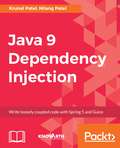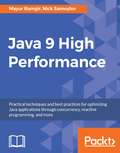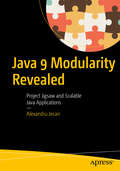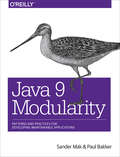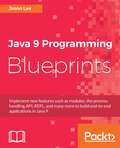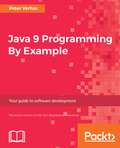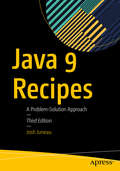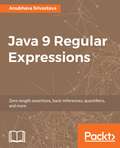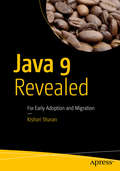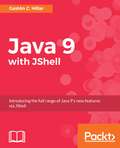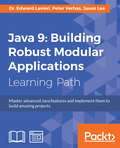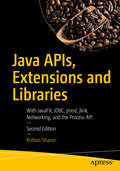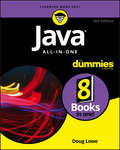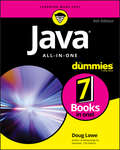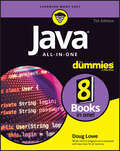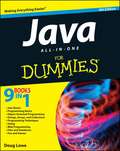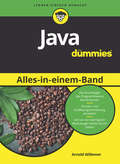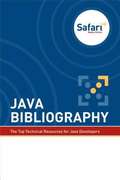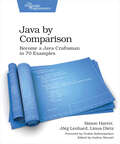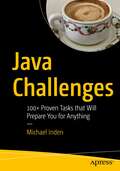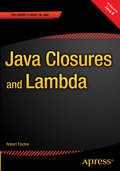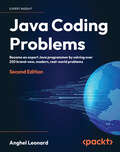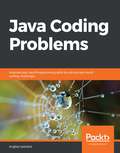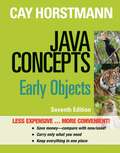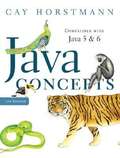- Table View
- List View
Java 9 Dependency Injection: Write loosely coupled code with Spring 5 and Guice
by Nilang Patel Krunal PatelCreate clean code with Dependency Injection principlesKey FeaturesUse DI to make your code loosely coupled to manage and test your applications easily on Spring 5 and Google GuiceLearn the best practices and methodologies to implement DIWrite more maintainable Java code by decoupling your objects from their implementationsBook DescriptionDependency Injection (DI) is a design pattern that allows us to remove the hard-coded dependencies and make our application loosely coupled, extendable, and maintainable. We can implement DI to move the dependency resolution from compile-time to runtime. This book will be your one stop guide to write loosely coupled code using the latest features of Java 9 with frameworks such as Spring 5 and Google Guice. We begin by explaining what DI is and teaching you about IoC containers. Then you’ll learn about object compositions and their role in DI. You’ll find out how to build a modular application and learn how to use DI to focus your efforts on the business logic unique to your application and let the framework handle the infrastructure work to put it all together. Moving on, you’ll gain knowledge of Java 9’s new features and modular framework and how DI works in Java 9. Next, we’ll explore Spring and Guice, the popular frameworks for DI. You’ll see how to define injection keys and configure them at the framework-specific level. After that, you’ll find out about the different types of scopes available in both popular frameworks. You’ll see how to manage dependency of cross-cutting concerns while writing applications through aspect-oriented programming.Towards the end, you’ll learn to integrate any third-party library in your DI-enabled application and explore common pitfalls and recommendations to build a solid application with the help of best practices, patterns, and anti-patterns in DI. What you will learnUnderstand the benefits of DI and fo from a tightly coupled design to a cleaner design organized around dependencies See Java 9’s new features and modular frameworkSet up Guice and Spring in an application so that it can be used for DIWrite integration tests for DI applicationsUse scopes to handle complex application scenariosIntegrate any third-party library in your DI-enabled applicationImplement Aspect-Oriented Programming to handle common cross-cutting concerns such as logging, authentication, and transactions Understand IoC patterns and anti-patterns in DI Who this book is forThis book is for Java developers who would like to implement DI in their application. Prior knowledge of the Spring and Guice frameworks and Java programming is assumed.
Java 9 High Performance: Boost Your Application's Performance With The New Features Of Java 9
by Nick Samoylov Mayur RamgirBest practices to adapt and bottlenecks to avoid About This Book • Tackle all kinds of performance-related issues and streamline your development • Master the new features and new APIs of Java 9 to implement highly efficient and reliable codes • Gain an in-depth knowledge of Java application performance and obtain best results from performance testing Who This Book Is For This book is for Java developers who would like to build reliable and high-performance applications. Prior Java programming knowledge is assumed. What You Will Learn • Work with JIT compilers • Understand the usage of profiling tools • Generate JSON with code examples • Leverage the command-line tools to speed up application development • Build microservices in Java 9 • Explore the use of APIs to improve application code • Speed up your application with reactive programming and concurrency In Detail Finally, a book that focuses on the practicalities rather than theory of Java application performance tuning. This book will be your one-stop guide to optimize the performance of your Java applications. We will begin by understanding the new features and APIs of Java 9. You will then be taught the practicalities of Java application performance tuning, how to make the best use of garbage collector, and find out how to optimize code with microbenchmarking. Moving ahead, you will be introduced to multithreading and learning about concurrent programming with Java 9 to build highly concurrent and efficient applications. You will learn how to fine tune your Java code for best results. You will discover techniques on how to benchmark performance and reduce various bottlenecks in your applications. We'll also cover best practices of Java programming that will help you improve the quality of your codebase. By the end of the book, you will be armed with the knowledge to build and deploy efficient, scalable, and concurrent applications in Java. Style and approach This step-by-step guide provides real-world examples to give you a hands-on experience.
Java 9 Modularity Revealed
by Alexandru JecanDevelop modular applications using the Java Platform Module System, the single most anticipated feature in Java 9. You will improve maintainability and performance of your Java applications by deploying only modules that are needed and encapsulating their implementation details. Until now Java has been monolithic. Using any one part of Java has meant incorporating the entirety of the runtime environment, an approach ill-suited to the increasing number of IoT devices such as fitness monitors, kitchen appliances, toys and games, and so forth. This book shows a new way, to make Java scale from the smallest of footprints in the smallest of devices through desktop PCs and on up to server platforms. With Java 9 Modularity Revealed you will learn to make your projects more reliable and scalable than ever using the most important feature in Java 9—The Java Platform Module System, known more commonly as Project Jigsaw. You will learn how to avoid one of the major pain points of Java programming, that of conflicting class names from different modules, or packages. You will learn to create custom run-time images that represent a minimal and more compact JRE containing only those modules that you need. You will further learn to migrate existing Java applications to modular ones using different approaches and tools. The end result is a new ability to plug together different modules without fear of namespace and other conflicts, and you can deploy to everything from small devices to large servers. This book provides code examples and explanations.What You'll Learn Build Java applications using the new modular system introduced in Java 9 Create your own JRE consisting only of the modules that you require Adapt your testing techniques toward modular applicationslare your dependencies on other modules Enable modules to export only specific packages Migrate existing Java applications to modular ones Improve maintainability and performance of Java applicationsWho This Book Is ForExperienced Java programmers wanting to keep up and become informed on the new modularity support in Java 9
Java 9 Modularity: Patterns and Practices for Developing Maintainable Applications
by Paul Bakker Sander MakThe upcoming Java 9 module system will affect existing applications and offer new ways of creating modular and maintainable applications. With this hands-on book, Java developers will learn not only about the joys of modularity, but also about the patterns needed to create truly modular and reliable applications. Authors Sander Mak and Paul Bakker teach you the concepts behind the Java 9 module system, along with the new tools it offers. You’ll also learn how to modularize existing code and how to build new Java applications in a modular way.Understand Java 9 module system conceptsMaster the patterns and practices for building truly modular applicationsMigrate existing applications and libraries to Java 9 modulesUse JDK 9 tools for modular development and migration
Java 9 Programming Blueprints
by Jason LeeBuild a variety of real-world applications by taking advantage of the newest features of Java 9 About This Book • See some of the new features of Java 9 and be introduced to parts of the Java SDK • This book provides a set of diverse, interesting projects that range in complexity from fairly simple to advanced and cover HTTP 2.0 • Take advantage of Java's new modularity features to write real-world applications that solve a variety of problems Who This Book Is For This book is for Java developers who are already familiar with the language. Familiarity with more advanced topics, such as network programming and threads, would be helpful, but is not assumed. What You Will Learn • Learn how to package Java applications as modules by using the Java Platform Module System • Implement process management in Java by using the all-new process handling API • Integrate your applications with third-party services in the cloud • Interact with mail servers using JavaMail to build an application that filters spam messages • Learn to use JavaFX to build rich GUI based applications, which are an essential element of application development • Write microservices in Java using platform libraries and third-party frameworks • Integrate a Java application with MongoDB to build a cloud-based note taking application In Detail Java is a powerful language that has applications in a wide variety of fields. From playing games on your computer to performing banking transactions, Java is at the heart of everything. The book starts by unveiling the new features of Java 9 and quickly walks you through the building blocks that form the basis of writing applications. There are 10 comprehensive projects in the book that will showcase the various features of Java 9. You will learn to build an email filter that separates spam messages from all your inboxes, a social media aggregator app that will help you efficiently track various feeds, and a microservice for a client/server note application, to name a few. The book covers various libraries and frameworks in these projects, and also introduces a few more frameworks that complement and extend the Java SDK. Through the course of building applications, this book will not only help you get to grips with the various features of Java 9, but will also teach you how to design and prototype professional-grade applications with performance and security considerations. Style and approach This is a learn-as-you-build practical guide to building full-fledged applications using Java 9. With a project-based approach, we'll improve your Java skills. You will experience a variety of solutions to problems with Java.
Java 9 Programming By Example
by Peter VerhasThis book is for anyone who wants to learn the Java programming language. You are expected to have some prior programming experience with another language, such as JavaScript or Python, but no knowledge of earlier versions of Java is assumed.
Java 9 Recipes
by Josh JuneauQuickly find solutions to dozens of common programming problems encountered while building Java applications. Content is presented in the popular problem-solution format. Look up the programming problem that you want to resolve. Read the solution. Apply the solution directly in your own code. Problem solved! This revised edition covers important new features such as Java 9's JShell and the new modularity features enabling you to separate code into independent modules that perform discrete tasks. Also covered are the new garbage collection algorithm and completely revamped process API. Enhanced JSON coverage is provided as well as a new chapter on JavaServer Faces development for web applications. What You'll Learn Develop Java SE applications using the latest in Java SE technology Exploit advanced features like modularity and lambdas Use JShell to quickly develop solutions Build dynamic web applications with JavaScript and Project Nashorn Create great-looking web interfaces with JavaServer Faces Generate graphics and work with media such as sound and video Add internationalization support to your Java applications Who This Book Is For Both beginning Java programmers and advanced Java developers
Java 9 Regular Expressions
by Anubhava SrivastavaSolve real world problems using Regex in Java. About This Book • Discover regular expressions and how they work • Implement regular expressions with Java to your code base • Learn to use regular expressions in emails, URLs, paths, and IP addresses Who This Book Is For This book is for Java developers who would like to understand and use regular expressions. A basic knowledge of Java is assumed. What You Will Learn • Understand the semantics, rules, and core concepts of writing Java code involving regular expressions • Learn about the java.util.Regex package using the Pattern class, Matcher class, code snippets, and more • Match and capture text in regex and use back-references to the captured groups • Explore Regex using Java String methods and regex capabilities in the Java Scanner API • Use zero-width assertions and lookarounds in regex • Test and optimize a poorly performing regex and various other performance tips In Detail Regular expressions are a powerful tool in the programmer's toolbox and allow pattern matching. They are also used for manipulating text and data. This book will provide you with the know-how (and practical examples) to solve real-world problems using regex in Java. You will begin by discovering what regular expressions are and how they work with Java. This easy-to-follow guide is a great place from which to familiarize yourself with the core concepts of regular expressions and to master its implementation with the features of Java 9. You will learn how to match, extract, and transform text by matching specific words, characters, and patterns. You will learn when and where to apply the methods for finding patterns in digits, letters, Unicode characters, and string literals. Going forward, you will learn to use zero-length assertions and lookarounds, parsing the source code, and processing the log files. Finally, you will master tips, tricks, and best practices in regex with Java. Style and approach This book will take readers through this learning journey using simple, easy-to-understand, step-by-step instructions and hands-on examples at every stage.
Java 9 Revealed: For Early Adoption and Migration
by Kishori SharanPreview the new Java 9 modules, SDK, JDK, JVM and more in this comprehensive early adopter title. This book covers what's new in Java 9 and how to use these new features. Java 9 Revealed is for experienced Java programmers looking to make the migration from Java 7 or Java 8 to Java 9. Author Kishori Sharan begins by covering how to develop Java applications using new the module system introduced in Java 9 and how to use the JShell tool in Java 9 for quick prototyping. There is extensive coverage of new Java 9 features, such as the new layout of the modular JDK/JRE runtime image, new convenience factory methods for creating collections, the new spin-wait hints introduced to improve performance of spin loops in your code, and the new Desktop API for implementing platform-specific desktop features. Along the way you will also learn how to use the Reactive Streams API in Java 9 and, most importantly, this book will show you the breaking changes in Java 9. What You'll Learn Discover what is new in the Process API Inspect a thread's stack with the Stack-Walking API Use the jlink tool to create a custom runtime image Work with HTML5 Javadoc and use the new search feature in Javadoc Learn how to use new methods and collectors in the Streams API Learn how to create a custom logger to log messages from platform classes and how to use JVM logs Learn about new methods in the Optional class and how to use them Learn how to compare arrays and slices of arrays Learn how to use the enhanced try-with-resources blocks Make your object deserialization more secure by using object deserialization filters Who This Book Is For Experienced Java programmers and developers.
Java 9 with JShell
by Gaston C. HillarExplore Java 9 with JShell and UML About This Book • A full account of Java 9's new features • This tutorial emphasises fluency using JShell exercises • Get a thorough introduction to contract programming code reuse via Java generics • Learn how to use the new module system • How to use proper functional programming style inside Java 9 Who This Book Is For This book can be understood by anyone who is a graduate of computer science or someone who has just begun working as a software engineer. Basically, an understanding of an object-oriented programming language like Python, C++ or indeed, an earlier Java version is sufficient. It would be helpful to have participated in the full product cycle of a software engineering project. What You Will Learn • Engage with object-oriented programming in Java 9, starting with code snippets in JShell • Optimize your code, applying functional programming features • Discover the advantages of modularity • Become very proficient at using JShell itself • Learn the new approach to Java programming, which uses the REPL as a prototyping tool In Detail The release of Java 9 has brought many subtle and not-so-subtle changes to the way in which Java programmers approach their code. The most important ones are definitely the availability of a REPL, known as JShell, which will make experiments and prototyping much more straightforward than the old IDE-based project-led approach. Another, more subtle change can be seen in the module system, which will lead to more modularized, maintainable code. The techniques to take full advantage of object-oriented code, functional programming and the new modularity features in Java 9 form the main subjects of this book. Each chapter will add to the full picture of Java 9 programming starting out with classes and instances and ending with generics and modularity in Java. Style and approach You will learn by doing: : using JShell as their prototyping environment, you will take full advantage of the new features of Java 9, in particular the full module system and the functional features of Java 9.. There won't be any theory, only small and medium-sized exampled enabling the reader to use the new Java features in professional software engineering projects.
Java 9: Master advanced Java features and implement them to build amazing projects
by Jason Lee Dr Edward Lavieri Peter VerhasMastering advanced features of Java and implement them to build amazing projectsKey Features Take advantage of Java's new modularity features to write real-world applications that solve a variety of problems Explore the major concepts introduced with Java 9, including modular programming, HTTP 2.0, API changes, and more Get to grips with tools, techniques and best practices to enhance application developmentBook DescriptionJava 9 and its new features add to the richness of the language; Java is one of the languages most used by developers to build robust software applications. Java 9 comes with a special emphasis on modularity with its integration with Jigsaw. This course is your one-stop guide to mastering the language.You'll be provided with an overview and explanation of the new features introduced in Java 9 and the importance of the new APIs and enhancements. Some new features of Java 9 are ground-breaking; if you are an experienced programmer, you will be able to make your enterprise applications leaner by learning these new features. You'll be provided with practical guidance in applying your newly acquired knowledge of Java 9 and further information on future developments of the Java platform. This course will improve your productivity, making your applications faster. Next, you'll go on to implement everything you've learned by building 10 cool projects. You will learn to build an email filter that separates spam messages from all your inboxes, a social media aggregator app that will help you efficiently track various feeds, and a microservice for a client/server note application, to name just a few.By the end of this course, you will be well acquainted with Java 9 features and able to build your own applications and projects.This Learning Path contains the best content from the following two recently published Packt products:•Mastering Java 9•Java 9 Programming BlueprintsWhat you will learn Package Java applications as modules using the Java Platform Module System Implement process management in Java using the all-new process handling API Integrate your applications with third-party services in the cloud Interact with mail servers, using JavaMail to build an application that filters spam messages Use JavaFX to build rich GUI-based applications, which are an essential element of application development Leverage the possibilities provided by the newly introduced Java shell Test your application's effectiveness with the JVM harness See how Java 9 provides support for the HTTP 2.0 standardWho this book is forThis learning path is for Java developers who are looking to move a level up and learn how to build robust applications in the latest version of Java.
Java APIs, Extensions and Libraries: Swing, Javafx, Javascript, Jdbc And Network Programming Apis
by Kishori SharanThis book completes the Apress Java learning journey and is a comprehensive approach to learning Java APIs, extensions, and modules such as Java EE integration, mobile Java modules, JavaFX, and JDBC. In this book, you'll learn how to build user interfaces with Swing and JavaFX as well as how to write network programs with the new Java 9 and much more.Java APIs, Extensions and Libraries is for Java programmers who are familiar with the fundamentals of the Java language and Java programming, who are now ready to call upon the power of extended Java functionality available from the huge array of Java APIs, extensions, and libraries. After reading and learning from this book you'll be ready to become a professional Java programmer.What You’ll LearnExtend your Java skills beyond the fundamental object-oriented concepts and core language featuresApply Java Swing for building Java front ends Get started with Java network programmingConnect to databases and access data from Java programs using the JDBC APIWork with JavaFX, RMI (Remote Method Invocation), and JNI (Java Native Interface)Use the new scripting features of JavaWho This Book Is ForJava programmers who are familiar with the fundamentals of the Java language and Java programming.
Java All-in-One For Dummies
by Doug LoweYour one-stop guide to programming with Java If you've always wanted to program with Java but didn't know where to start, this will be the java-stained reference you'll turn to again and again. Fully updated for the JDK 9, this deep reference on the world's most popular programming language is the perfect starting point for building things with Java—and an invaluable ongoing reference as you continue to deepen your knowledge. Clocking in at over 900 pages, Java All-in-One For Dummies takes the intimidation out of learning Java and offers clear, step-by-step guidance on how to download and install Java tools; work with variables, numbers, expressions, statements, loops, methods, and exceptions; create applets, servlets, and JavaServer pages; handle and organize data; and so much more. Focuses on the vital information that enables you to get up and running quickly with Java Provides details on the new features of JDK 9 Shows you how to create simple Swing programs Includes design tips on layout, buttons, and labels Everything you need to know to program with Java is included in this practical, easy-to-use guide!
Java All-in-One For Dummies
by Doug LoweJava—from first steps to first apps Knowing Java is a must-have programming skill for any programmer. It’s used in a wide array of programming projects—from enterprise apps and mobile apps to big data, scientific, and financial uses. The language regularly ranks #1 in surveys of the most popular language based on number of developers, lines of code written, and real-world usage. It’s also the language of choice in AP Computer Science classes taught in the U.S. This guide provides an easy-to-follow path from understanding the basics of writing Java code to applying those skills to real projects. Split into eight minibooks covering core aspects of Java, the book introduces the basics of the Java language and object-oriented programming before setting you on the path to building web apps and databases. • Get up to speed on Java basics • Explore object-oriented programming • Learn about strings, arrays, and collections • Find out about files and databases Step-by-step instructions are provided to ensure that you don't get lost at any point along the way.
Java All-in-One For Dummies
by Doug LoweA beginning coder’s resource for learning the most popular coding language With Java All-in-One For Dummies, you get 8 books in one, for the most well-rounded Java knowledge on the market. Updated for Java 19, this book includes all the major changes to the programming language, so you won’t fall behind. Start by learning the basics of Java—you can do it, even if you’ve never written a line of code in your life. Then go in-depth, with all the info you need on object-oriented programming, Java FX, Java web development, and beyond. Grab a hot cup of java and settle in to learn some Java, with friendly For Dummies guidance! Learn the basics of computer programming and get started with the Java language Master strings, arrays, and collections Discover the most recent Java updates and the latest in programming techniques Launch or further your career as a coder with easy-to-follow instructionThis is the go-to Dummies guide for future and current coders who need an all-inclusive guide Java to take their knowledge to the next level.
Java All-in-One For Dummies
by LoweEverything you need to get going with Java!Java All-in-One For Dummies, 4th Edition has what you need to get up and running quickly with Java. Covering the enhanced mobile development and syntax features as well as programming improvements, this guide makes it easy to find what you want and put it to use. Focuses on the vital information that enables you to get up and running quickly with Java Covers the enhanced multimedia features as well as programming enhancements, Java and XML, Swing, server-side Java, Eclipse, and more Minibooks cover Java basics; programming basics; strings, arrays, and collections; programming techniques; Swing; Web programming; files and databases; and a "fun and games" categoryJava All-in-One For Dummies, 4th Edition focuses on the practical information you need to become productive with Java right away.
Java Alles-in-einem-Band für Dummies (Für Dummies)
by Arnold V. WillemerDieses Buch ist für alle, die tief in die Java-Programmierung einsteigen möchten. Dennoch werden keine Programmierkenntnisse vorausgesetzt. Lernen Sie zunächst, wie Sie das Java Development Kit installieren und welche Java-Elemente es gibt. Machen Sie sich dann mit Methoden und objektorientierter Programmierung vertraut. Werfen Sie Exceptions, sammeln Sie Datenelemente in flexiblen Arrays und programmieren Sie Fenster, Mäuse und Grafik. Merken Sie was? Unversehens sind Sie zum Profi geworden. Datenspeicherung, Datenbankzugriff und der Umgang mit XML-Dateien sind genauso wie die Parallelverarbeitung mit Threads und die Netzwerkprogrammierung keine Hürde mehr. Programmieren lernt man in erster Linie dadurch, dass man es tut: Deshalb sind Aufgaben vorhanden. Die Lösungen dazu und alle Codebeispiele des Buchs stehen zum Download zur Verfügung.
Java Bibliography
by Safari Content TeamIn the early 1990s, a team of developers at Sun Microsystems, led by James Gosling, designed and implemented a new computer language: Java. The language was object oriented, was compiled into an intermediate form called Java Bytecode, and those bytecode instructions were run on a virtual machine called the Java VM. Java, at the time, was a revolution in itself. It quickly became the language of a new generation of software developers who were writing small applications for the web, server applications for the enterprise, and even desktop applications. Today many new languages compile into Java bytecode and are run on top of the Java VM such as Scala, Groovy and Clojure, as well as variants of Python, Ruby, and Erlang. Java is also the language used to write programs for many of the world's mobile devices, including Android. If you're interested in Android development, there is also a bibliography specific to that platform. Oracle acquired Sun Microsystems in January of 2010 and became the owner of the Java technology. So far, this has not changed how Java has been positioned in the market. Open source software projects have used Java extensively to create some of the world's most popular software libraries. These libraries have likely been one of the driving forces behind the creation of many of the JVM based language ports. Of course, people have to learn about how to use these libraries and languages, so the books written about Java are also varied in nature. There are a great many excellent learning reference books, class library reference books, and books on enterprise and web development. There are books that cover the Java Virtual Machine based languages mentioned earlier. The Spring Framework is a highly popular, open source, modular, infinitely configurable framework written in Java that is also covered well by technical book writers. Many games are written in Java, and we've included a few books on Game programming. If you are writing web services, you'll want to read about Service Oriented Architecture as well as storing and retrieving data using one of the many Java persistence frameworks. This bibliography covers the entire Java language, spanning from introductory to advanced topics. We hope you enjoy them and use them to your
Java By Comparison
by Simon Harrer Jörg Lenhard Linus DietzWrite code that's clean, concise, and to the point: code that others will read with pleasure and reuse. Comparing your code to that of expert programmers is a great way to improve your coding skills. Get hands-on advice to level up your coding style through small and understandable examples that compare flawed code to an improved solution. Discover handy tips and tricks, as well as common bugs an experienced Java programmer needs to know. Make your way from a Java novice to a master craftsman. This book is a useful companion for anyone learning to write clean Java code. The authors introduce you to the fundamentals of becoming a software craftsman, by comparing pieces of problematic code with an improved version, to help you to develop a sense for clean code. This unique before-and-after approach teaches you to create clean Java code. Learn to keep your booleans in check, dodge formatting bugs, get rid of magic numbers, and use the right style of iteration. Write informative comments when needed, but avoid them when they are not. Improve the understandability of your code for others by following conventions and naming your objects accurately. Make your programs more robust with intelligent exception handling and learn to assert that everything works as expected using JUnit5 as your testing framework. Impress your peers with an elegant functional programming style and clear-cut object-oriented class design. Writing excellent code isn't just about implementing the functionality. It's about the small important details that make your code more readable, maintainable, flexible, robust, and faster. Java by Comparison teaches you to spot these details and trains you to become a better programmer. What You Need: You need a Java 8 compiler, a text editor, and a fresh mind.That's it.
Java Challenges: 100+ Proven Tasks that Will Prepare You for Anything
by Michael IndenExpand your knowledge of Java with this entertaining learning guide, which features 100+ exercises and programming challenges. Java Challenges will prepare you for your next exam or job interview, and covers many practical topics, such as strings, arrays, data structures, recursion, and date and time. The APIs and other material included in this book are Java 17 compatible. Each topic is addressed in its own separate chapter, starting with an introduction to the basics and followed by multiple exercises of varying degrees of difficulty, helping you to improve your programming skills effectively. Detailed sample solutions, including the algorithms used for all tasks, are included to maximize your understanding of each area. Author Michael Inden also describes alternative solutions and analyzes possible pitfalls and typical errors. Three appendices round out the book: one covering JShell, which is often helpful for trying out the code snippets and examples in the book, followed by an introduction to JUnit 5 for unit testing and verifying solutions, while the final appendix explains O-notation for estimating performance. After reading this book, you'll be prepared to take the next step in your career or tackle your next personal project. All source code is freely available for download via the Apress website. What You Will Learn Improve your Java knowledge by solving enjoyable but challenging programming puzzles Solve mathematical problems, recursions, strings, arrays and moreManage data processing and data structures like lists, sets, mapsHandle advanced recursion as well as binary trees, sorting and searching Gamify key fundamentals for fun and easier reinforcement Who This Book Is For Professional software developers, makers, as well as computer science teachers and students. At least some prior experience with Java programming is recommended.
Java Closures and Lambda
by Robert FischerJava Closures and Lambda introduces you to significant new changes to the Java language coming out of what is termed Project Lambda. These new changes make their debut in Java 8, and their highlight is the long-awaited support for lambda expressions in the Java language. You'll learn to write lambda expressions and use them to create functional interfaces and default methods for evolving APIs, among many other uses. The changes in Java 8 are significant. Syntax and usage of the language are changed considerably with the introduction of closures and lambda expressions. This book takes you through these important changes from introduction to mastery. Through a set of clear examples, you'll learn to refactor existing code to take advantage of the new language features. You'll learn what those features can do for you, and when they are best applied. You'll learn to design and write new code having these important new features in mind from the very beginning. Clearly explains the fantastic benefits resulting from Project Lambda Explains the syntax and IDE support for the new features Shows how to streamline your code by bringing some of the benefits of functional programming to the Java language Illustrates parallelism in closures through Stream and Spliterator objects Explains API evolution by adding methods to existing interfaces without breaking existing interface implementations, a technique addressing potential multiple inheritance issues
Java Coding Problems: Become an expert Java programmer by solving over 250 brand-new, modern, real-world problems
by Anghel LeonardStay on top of the new Java features (up to JDK 21) and find efficient solutions for your programming woes. With over 250 problems and solutions, you'll learn new ways to deal with real-world coding tasks and answers to common interview questions. Purchase of the print or Kindle book includes a free PDF eBookKey FeaturesSolve Java programming challenges and get interview-ready with the power of modern Java 21Test your Java skills using language features, algorithms, data structures, and design patternsExplore tons of examples, all fully refreshed for this edition, meant to help you accommodate JDK 12 to JDK 21Book DescriptionThe super-fast evolution of the JDK between versions 12 and 21 has made the learning curve of modern Java steeper, and increased the time needed to learn it. This book will make your learning journey quicker and increase your willingness to try Java’s new features by explaining the correct practices and decisions related to complexity, performance, readability, and more. Java Coding Problems takes you through Java’s latest features but doesn’t always advocate the use of new solutions — instead, it focuses on revealing the trade-offs involved in deciding what the best solution is for a certain problem. There are more than two hundred brand new and carefully selected problems in this second edition, chosen to highlight and cover the core everyday challenges of a Java programmer. Apart from providing a comprehensive compendium of problem solutions based on real-world examples, this book will also give you the confidence to answer questions relating to matching particular streams and methods to various problems. By the end of this book you will have gained a strong understanding of Java’s new features and have the confidence to develop and choose the right solutions to your problems.What you will learnAdopt the latest JDK 21 features in your applicationsExplore Records, Record Patterns, Record serialization and so onWork with Sealed Classes and Interfaces for increasing encapsulationLearn how to exploit Context-Specific Deserialization FiltersSolve problems relating to collections and esoteric data structuresLearn advanced techniques for extending the Java functional APIExplore the brand-new Socket API and Simple Web ServerTackle modern Garbage Collectors and Dynamic CDS ArchivesWho this book is forIf you are a Java developer who wants to level-up by solving real-world problems, then this book is for you. Working knowledge of the Java programming language is required to get the most out of this book
Java Coding Problems: Improve your Java Programming skills by solving real-world coding challenges
by Anghel LeonardDevelop your coding skills by exploring Java concepts and techniques such as Strings, Objects and Types, Data Structures and Algorithms, Concurrency, and Functional programming Key Features Solve Java programming challenges and get interview-ready by using the power of modern Java 11 Test your Java skills using language features, algorithms, data structures, and design patterns Explore areas such as web development, mobile development, and GUI programming Book Description The super-fast evolution of the JDK between versions 8 and 12 has increased the learning curve of modern Java, therefore has increased the time needed for placing developers in the Plateau of Productivity. Its new features and concepts can be adopted to solve a variety of modern-day problems. This book enables you to adopt an objective approach to common problems by explaining the correct practices and decisions with respect to complexity, performance, readability, and more. Java Coding Problems will help you complete your daily tasks and meet deadlines. You can count on the 300+ applications containing 1,000+ examples in this book to cover the common and fundamental areas of interest: strings, numbers, arrays, collections, data structures, date and time, immutability, type inference, Optional, Java I/O, Java Reflection, functional programming, concurrency and the HTTP Client API. Put your skills on steroids with problems that have been carefully crafted to highlight and cover the core knowledge that is accessed in daily work. In other words (no matter if your task is easy, medium or complex) having this knowledge under your tool belt is a must, not an option. By the end of this book, you will have gained a strong understanding of Java concepts and have the confidence to develop and choose the right solutions to your problems. What you will learn Adopt the latest JDK 11 and JDK 12 features in your applications Solve cutting-edge problems relating to collections and data structures Get to grips with functional-style programming using lambdas Perform asynchronous communication and parallel data processing Solve strings and number problems using the latest Java APIs Become familiar with different aspects of object immutability in Java Implement the correct practices and clean code techniques Who this book is for If you are a Java developer who wants to level-up by solving real-world problems, then this book is for you. Working knowledge of Java is required to get the most out of this book.
Java Concepts (Seventh Edition)
by Cay S. HorstmannCay Horstmann's seventh edition of Java Concepts provides an approachable introduction to fundamental programming techniques and design skills, helping students master basic concepts and become competent coders. Major rewrites and an updated visual design make this student-friendly text even more engaging. The text is known for its realistic programming examples, great quantity and variety of homework assignments, and lab exercises that build student problem-solving abilities. The seventh edition now includes problem solving sections, more example code online, and exercises from Science and Business.
Java Concepts,Fifth Edition
by Cay HorstmannUpdated to integrate Java 6, Java Concepts, Fifth Edition introduces you to fundamental programming techniques and design skills that are crucial to learning how to program.
